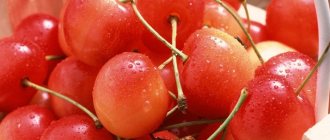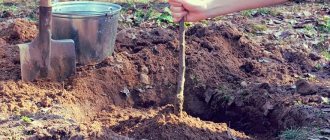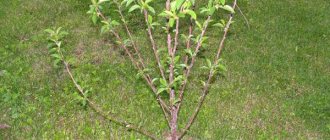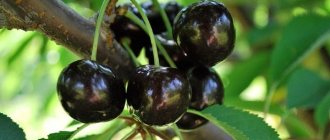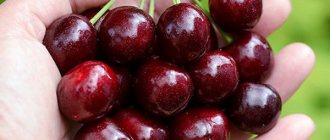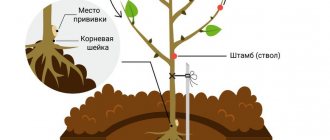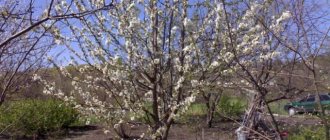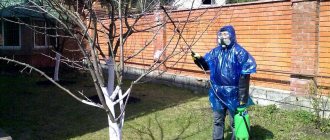A brief excursion into history
Sweet cherry Fatezh: photo of the variety
Fatezh cherry was bred by Russian breeders. Authorship belongs to: Evstratov A.I., Enikeev H.K. The variety was obtained on the basis of the All-Russian Selection and Technological Institute of Horticulture and Nursery Growing. Scientists took biostimulants and gamma rays as the basis for selection.
In 1999, after breeders successfully experimented with the Leningradskaya Yellow cherry, the result was a new hybrid variety. It was named after the city of Fatezh, which is located in the Kursk region. The variety was on trial for two years; eventually it was included in the state register in 2001 and zoned in the Center and the North-West.
Harvest
Around the end of June, you can begin to gradually collect ripe berries, but sometimes they ripen only at the beginning of July - it depends on the weather and climate. To be consumed fresh, the berries must be picked after they are fully ripe. For preservation or for heat treatment - 3 days before ripening, and for transportation over long distances - 1 week. The collected cherries are stored for no more than 10 days at a temperature of 0...+1 degrees.
To be consumed fresh, berries must be picked after they are fully ripe.
Fatezh cherries can be consumed fresh or used for processing. It makes delicious preserves, compotes, jam. During heat treatment, the skin does not crack and therefore the shape of the berries is preserved.
Sweet cherry Fatezh: variety description and characteristics
The Fatezh cherry variety can be successfully grown in the Moscow region and in the center of Russia. In the northwestern territory, you can also get high yields, because the crop is recommended for cultivation in regions with changeable climatic conditions; in addition, Fatezh cherries are highly resistant to frosty temperatures. In another climate of our country, it is impossible to cultivate the variety we are considering due to the cold, long-lasting winter seasons.
The Fatezh cherry tree is quite tall, reaching three meters, the tallest trees grow up to five meters high. The crown is lush, spreading and round, because the mature branches bend towards the ground. The bark is brown and smooth. The leaves are arranged quite densely on the branches. The leaf blade is elongated and wide, with jagged edges, soft, its surface is shiny and rich, and the inner side has a lighter shade and texture due to the veins.
Sweet cherry Fatezh: photo of the variety
The secret of the Fatezh cherry variety is that it contains all the main indicators that are characteristic of plants grown in the north.
- Drought resistance and winter resistance.
Winter resistance is above average. The tree can withstand frost temperatures down to minus twenty-seven to thirty-five degrees; the buds can often suffer from repeated cold spells. If you take good care of the tree, it will recover in a few years and will produce fruit as before.
The variety tolerates drought well because it likes to grow in light, well-drained soils. And cherries have an extremely negative attitude towards stagnant liquid.
- Cherry pollinators Fatezh, flowering, ripening.
For the first time, the cherry variety Fatezh begins to bloom in the fourth year after planting, at the same time the leaves bloom. Brilliant-white flowers are formed on the five lower buds of young shoots or on bouquet branches. The fruits fully ripen from June 20-30 to July 1-10.
Cherry Fatezh is not self-fertile. In this regard, to form a harvest, it requires varieties for pollination growing in the neighborhood. Suitable pollinators for the Fatezh cherry are: “Revna”, “Iput”, “Bryanskaya”.
- Yield indicator, fruiting.
The Fatezh cherry variety begins to bear fruit in the fourth year, and produces the most record harvests after ten years. By this time, thirty kg of fruits are collected from each cherry. The record maximum yield is fifty kg per tree. The fruits are yellow-red in color, round, slightly flattened. One berry weighs from four to six grams. The internal contents of the cherry are juicy, the skin is dense and smooth, and therefore the fruits are easily transported and stored.
- Where is the crop used?
Dessert fruits. Mostly sweet, slightly sour. The taste rating is very high. During heat treatment, deformation of the berries does not occur. Therefore, the fruits can be eaten fresh, canned and added to pies.
- Immunity to diseases and resistance to harmful insects.
The Fatezh cherry variety is endowed with good immune protection to combat fungal diseases, therefore, it cannot be affected by such well-known infections as moniliosis and coccomycosis. Among the pests, cherry flies, aphids, and moths are especially dangerous. The Fatezh cherry variety is prone to only one disease - gum disease, but it can be easily avoided if you follow cultivation recommendations.
- Advantages and disadvantages.
Advantages.
- The variety can withstand frost well.
- Thanks to the growth of the tree and the convenient location of the branches, you can comfortably collect fruits.
- The fruits lie and are stored well.
- Decent tasting assessment of taste.
- High immunity to fungal diseases.
Flaws.
- Self-sterile variety.
- Low resistance to gum development.
- It can be grown in certain regions (there are few of them).
Growing technology
Agricultural cultivation technology begins with the selection of high-quality planting material, a suitable site and method of planting the seedling. At the stage of crop care, the main emphasis is on crown formation, treatment of the root circle and disease prevention.
Optimal conditions
Cherries grow only in light, well-drained soil with good aeration. Suitable soils are sandy loam and loam with neutral or slightly alkaline acidity. The permissible proximity to groundwater is 1.5 m. Trees are not planted in lowlands - stagnation of cold air reduces frost resistance. In flooded, swampy areas, the crop dies.
Landing dates and rules
A flat or elevated sunny area with protection from drafts is suitable for cherries. The optimal places are the southern location of the garden, the southern side of the house (3-4 m from the building). Self-sterile varieties are planted in pairs at a distance of 3-4 m. The minimum distance with other garden crops is 5 m. A powerful superficial root system can inhibit the development of neighboring trees.
Good neighborhood:
- cherries;
- cherry;
- columnar cherry plum;
- black elderberry;
- grape.
Invalid proximity:
- Apple tree;
- plum;
- apricot;
- peach;
- pear;
- nut;
- currant.
Cherries are planted in the spring at a stable temperature of +5°C or in the fall, a month before the first frost. One-year and two-year seedlings develop faster. Seedlings with a closed root system take root better - in containers.
Options for selection:
- exposed roots should be moist, branched, light-colored when cut;
- shoots are clean, straight, without damage, in two-year-olds - 3-5 pcs.;
- the conductor is not forked, the trunk diameter of one-year-olds is 1.5-2 cm, two-year-olds are 2-2.5 cm, height is from 0.8 to 1 m;
- at the site of budding, a slight curvature without a protruding thorn is noticeable (15-20 cm from the root).
The holes are prepared in advance so that the earth has time to settle.
Procedure:
- The area is cleared of roots and larvae.
- The size of the cubic hole is 70x70x60 cm.
- The bottom of the planting pit is covered with drainage made of fine crushed stone.
- Add 2 buckets of humus, 1 bucket of compost, 1 kg of wood ash, 300 g of bone meal to the soil. Heavy soil is additionally diluted with sand.
- The nutrient mixture is poured into the hole and watered generously. For spring planting, the site is prepared in the fall, and for autumn planting, from the beginning of summer.
- If a tree cannot be planted in a hole (due to the proximity of groundwater, flooding, lowlands), an artificial hill about 70 cm high is formed. The area is covered with turf, roots up, hay, chopped grass, a mound of nutrient mixture is poured, watered abundantly and covered with roofing felt.
- After the earth has settled, a small depression is made in the hole or on the hill.
- The roots of the seedling are straightened and installed so that the root collar remains 2 cm above the soil level.
- The hole is filled with soil. The seedling is tied to a peg. The branches are cut by 1/3. If there are no branches, it is shortened to 60 cm.
- A tree trunk circle with a diameter of 60-70 cm is formed.
- Water the cherries (1-2 buckets) gradually until all the water is absorbed. The tree trunk area is mulched with a layer of organic matter about 10 cm.
Further care
The crown is formed and systematically trimmed. Water rarely, but abundantly. Once every three years the tree trunk circle is expanded.
Crown formation
Cherries are pruned only in the spring, before the buds swell. To obtain a low standard, annual seedlings are shortened to 50-60 cm.
From the second year, 5-6 strong branches are left. All branches are cut by 1/3. The central conductor remains erect. The lower tier of skeletal branches is formed from the lateral ones. They are bent at right angles and secured with stretch marks. In summer, the ends are trimmed again.
In the third year, skeletal branches of the second row are also formed, leaving no erect ones. They should be shorter than the lower tier so that the tree looks like a bowl.
The crown is formed before the fifth year. All cuts are treated with brilliant green and garden pitch.
Watering
Cherries are watered four times a season: before and after flowering, during fruiting, and before the first frost. For young trees, use 2-3 buckets of water, for adults - up to 5 buckets, so that the soil in the root zone is saturated with moisture to a depth of 40 cm. After watering, the weeds are removed and the soil is loosened.
Top dressing
In spring and autumn, seedlings are fed with wood ash, 200 g each. With the beginning of fruiting, add a bucket of humus or compost, 2 tbsp. a mixture of ash and bone meal.
Processing the tree trunk circle
In the second year, the tree trunk zone is increased to 1 m and expanded once every 3 years so that the radius corresponds to the diameter of the crown. The soil is loosened and mulched. The mulch is renewed every season.
Possible problems, diseases, pests
Errors in agricultural technology affect the development and productivity of trees.
Possible problems:
- The seedlings do not take root - poor-quality planting material, the wrong time for planting.
- Seedlings develop slowly - shaded area, drafts, plants older than 2-3 years are selected.
- Diseases and pest damage - waterlogging, drought, poorly formed and treated trunk area, sanitary pruning and disease prevention are not carried out.
- Uneven distribution of fruits on the branches is an error in the formation of the crown.
Poor care of cherries reduces winter hardiness.
Pests of crops:
- Tube screwer. The beetles feed on buds and flowers and gnaw through fruits. Glue traps are attached to the trunk and treated with “Bitoxibacillin” at the beginning of flowering.
- The cherry fly damages the fruit. For the fight, the drugs “Actellik” or “Confidor” are used.
- Aphids settle on young shoots. The leaves turn black and the formation of flower buds stops. In spring, trees are treated with Confidor.
- Leaf roller. Caterpillars damage leaves, ovary and tree bark. Stripping and processing of wood is carried out after harvesting. Use chlorophos and copper sulfate. Treat in the spring, before the buds open.
Possible diseases:
- Gum discharge (gommosis) - resinous deposits on the bark. A sign of insect infestation, the presence of diseases or infections after mechanical damage to the bark. The wounds are cleaned, disinfected and covered with garden varnish.
- Clusterosporiosis - dark spots and holes on the leaves, shoots dry out. Trees are treated with Nitrophen before buds begin to bloom.
Sick trees are treated after sanitary pruning.
Wintering
In the fall, before frost, the root zone is loosened, watered abundantly and mulched. The trunk is whitened. For mature trees, a mixture based on slaked lime is used, for young trees - chalk.
The seedlings are insulated. A frame is installed around the plant and covered with a breathable film (agrospan, spunbond). Work is carried out at air temperature +2…0°C. In spring, the shelter is removed after the snow melts.
Reproduction
Cherries can be grown from seed, but the tree will lose its varietal benefits. This breeding system is used by breeders to develop a new variety.
A common method is vaccination. It is done in mid-April. A scutum about 30 cm long with a bud is cut from a green cutting. On a scion tree, the bark is cut along the length of the shield. Part of the bark is removed. 8-10 cm remains. The shield is inserted under the bark so that the bud is open. The scion and rootstock are tightly covered with electrical tape or plaster.
Propagation by cuttings is carried out in early June. Shoots of about 15 cm are cut from the lower branches. Leaves are left only at the top. The cuttings are placed in a container with a growth stimulator and kept for 8-12 hours. Planted in a greenhouse, in nutritious soil, with a depth of 3-5 cm and maintain a temperature of at least 24°C. Water 3 to 6 times a day to keep the soil constantly moist. They are transplanted to a new site in the spring.
cherry propagation
Features of cultivation depending on the region
In the southern regions, cherries are planted in the fall. The root system has time to strengthen, and the tree gains strength. For the winter, seedlings are not insulated with frame protection.
In the northern regions of the Central region, given the short autumn, only spring planting of seedlings is possible.
Pollinator varieties
The best pollinators for Fatezh cherries are Iput and Chermashnaya. With such a partnership, trees show maximum productivity. Raditsa, Ovstuzhenka, Sinyavskaya, Krymskaya, Revna are also suitable.
Cherry Fatezh: planting varieties
Sweet cherry Fatezh: photo of the variety
The Fatezh cherry variety should be planted in the same way as other varieties. The peculiarities of planting are related more to the climate, because the Fatezh cherry variety is recommended for growing in areas where cherry trees have not been planted in principle.
- Optimal time for planting Fatezh cherries
In the Center and North-West, it is advisable to plan planting for the spring season, because young and weak seedlings may not withstand frosty temperatures after planting in the fall.
In the south with a mild winter period, planting can be done in October days, fifteen to twenty days before the onset of cold weather. During this period, the tree will successfully take root in the new area. The condition of the roots also affects the time of planting. Planting material with an open root system takes root only when planted in the spring; seedlings with closed roots successfully adapt in both the spring and autumn seasons.
The best time for planting Fatezh cherries in the spring is the days of April; with the late onset of the spring season, planting is postponed to the first days of May.
- How to choose a suitable site for planting Fatezh cherries
The Fatezh cherry variety is particular about the quality of the soil and its location on the site. Heavy clay soils on which underground waters lie closely, as well as open spaces with gusty and through winds, slopes from the north, places in the shade, and low-lying areas are prohibited for planting.
Places that are protected from the winds are excellent for planting varieties: old garden plots, forest edges and south-facing slopes. You can plant a tree along the walls of buildings, but a distance of at least three meters from them is required in order to avoid future problems with the foundation.
Keep in mind that the cherry tree needs a place well lit by the sun and light, well-drained loam. The acid content in the soil should be neutral - six to seven pH. Groundwater should lie two meters deep, no less. Otherwise, you will have to build a high ridge or create high-quality drainage.
- What plants are allowed and prohibited to be planted near Fatezh cherries?
The Fatezh cherry variety is self-sterile, so it is necessary to sow honey-bearing herbaceous crops nearby. They will attract insects and prevent weed growth. Plants such as clover, mustard, and phacelia are suitable for this role.
In order for the tree to grow actively, crops with fruits that have pits are suitable: cherry, apricot, plum, grape.
It is forbidden to plant plants near: nightshades (tomatoes, potatoes, peppers), as they spread diseases; gooseberries, raspberries, currants - steal food; sea buckthorn - because of it, the cherry root system does not develop.
- How to select and prepare Fatezh cherry seedlings
Buy high-quality planting material from a trusted supplier. The best plant height for planting is one meter, the root system should be twenty-five cm. The seedling should contain five healthy branches, approximately two cm in thickness.
Before purchasing, carefully inspect all cherry fragments. They must be intact and undamaged. If the roots are black, this means that the plant is sick. Inspect the foliage from all sides, because harmful insects and diseases can often hide at the bottom of the leaf.
Do not choose a very tall plant, as it will take root less well. There should be a slight curvature at the bottom of the stem (five to fifteen cm from the ground), this is the grafting site.
- Progress of planting work
Pits for planting Fatezh cherries are prepared in the autumn season, this does not depend on the time of planting. The dimensions of the hole are seventy by seventy by seventy cm. If you plan to plant more than one tree, then leave an interval of three meters between the holes.
A drainage layer up to seven cm thick is laid at the bottom of the pit. The drainage can consist of expanded clay or broken brick. Next, the soil mixture is laid out; it contains ash (one kg), sodium sulfate (0.1 kg), superphosphate (0.4 kg). Then an earthen layer is laid, ten cm thick.
A seedling is placed on this layer, the roots are carefully straightened. A stake is driven in near the plant and a cherry tree is tied to it. The hole is filled with soil so that the root collar is deepened by five to eight cm. The soil is compacted and thoroughly watered with thirty liters of water. A mulch of peat or humus is laid on top (a layer of three to five cm).
Tree care
Soil care
Sweet cherries need regular loosening of the tree trunk and clearing it of weeds, especially at a young age (up to 5–6 years). These operations are usually performed after watering, when the soil dries out a little. In this way, you can immediately achieve three goals - destroy the soil crust, improve soil aeration and eliminate weeds. The depth of loosening should be 15–20 cm at the border of the trunk circle and 8–10 cm near the trunk. After loosening, it is advisable to cover the soil with mulch - peat or sawdust will do.
The soil in the tree trunk circle must be regularly dug up and freed from weeds.
When the tree reaches 6–7 years of age, you can begin to sow the tree trunk circle with a lawn mixture, leaving a strip of clean soil 40–50 cm wide near the trunk. Sodding makes loosening the soil unnecessary. The grass should be mowed regularly. If you add clover seeds to the lawn mixture, you can also enrich the soil with nitrogen.
Watering
Fatezh cherry needs 3-5 waterings per season (more waterings in dry weather). The water requirement for a young tree is 3-4 buckets, for an adult - 6-8 buckets. Irrigation can be done by drip, sprinkling or temporary furrows.
In the fall (mid-October), moisture-recharging irrigation is carried out, which improves the soil's storage capacity and improves the wintering conditions of the tree.
Trimming
Pruning of fruit trees is divided into formative, thinning and sanitary. The first two types of pruning must be carried out in spring or autumn (during the dormant period of the tree), and sanitary pruning (removal of diseased wood) can be done at any time if the need arises.
Pruning should not be done at sub-zero temperatures. The cuts should be immediately covered with a thin layer of garden varnish.
Cherry is a self-forming tree, but if desired, the crown can be formed in a way convenient for the owner. For example, when planting a tree near a building or fence, you can grow it in a fan shape.
Formation of fan-type cherries in the photo
In the first and second years, the base branches of the lower tier of the year are formed.
In the third year, trusted branches of the second order are formed, and in the fourth and subsequent years, thinning of excess growth is carried out
The formed fan crown requires regular thinning and stimulating pruning
For those who do not like the “weeping” nature of the tree, we can recommend pruning the branches above the buds pointing upward. This allows you to change the shape of the crown to some extent.
At a young age, Fatezh cherries are distinguished by intensive shoot growth, which should be restrained by annual pruning. One-year growth is shortened by 1/5 of the length. In addition, improperly growing branches should be cut out. After 5 years, growth and branching activity decreases, so annual pruning can be stopped. Only occasionally may it be necessary to remove branches growing inside the crown or new forks.
Pruning and shaping cherries on video
Top dressing
The cherry tree requires a large amount of nutrients for full development. They should be applied along the periphery of the trunk circle, where the bulk of the suction roots are located.
In the first 2 years after planting, there is no need to feed the tree - its nutrition is provided by fertilizers added to the planting hole. It is not recommended to apply fertilizers too often - this provokes rapid growth, which often does not have time to mature before the cold weather.
Rotted manure is one of the best organic fertilizers
Every year in the spring, before the buds open, 20–25 liters of a solution of mineral fertilizers are applied to each tree (20–25 g of urea and potassium sulfate per bucket of water). In the autumn, after harvesting, 0.2 kg of superphosphate and 0.1 kg of potassium sulfate are applied (fertilizers are distributed over the soil surface in dry form, then watered). Organic fertilizers (3–5 buckets of compost or humus) are applied during spring or autumn digging of the soil. In the summer, after flowering, you can feed the tree with Agricola complex mineral fertilizer (2 tablespoons per bucket of water). The same drug can be added during spring and autumn feeding.
Preparing for winter
Fatezh has high winter hardiness and does not need to be insulated. To protect against overwintering pests in the fall, the trunk and main branches should be whitened with a thick (creamy consistency) clay-lime solution.
It is useful to cover the soil under young trees with a layer of sawdust 25–30 cm thick for the winter.
Mulching with a thick layer of sawdust will help protect the root system from freezing
Cherry buds may be damaged in the spring by returning frosts. If there is a threat of frost, smoke can be organized, and small trees can be covered with burlap.
To protect against rodents, tie the trunk and main branches with something prickly - spruce branches, metal mesh.
You can protect a tree trunk from rodents using a cut plastic pipe
Cherry Fatezh: care
Sweet cherry Fatezh: photo of the variety
Next, the Fatezh cherry tree is cared for according to the standard.
- Water once or twice every thirty days with twenty liters of water under the tree.
- Weed and loosen the tree trunk circle.
- Pruned: in spring (for shaping) and in autumn (for sanitary purposes).
- They are fed in the spring season (with a complex of minerals) and in the autumn (with organic fertilizers).
- Shelter for the winter.
Landing algorithm
Fatezh cherries (a description of the variety and photos will help you find the optimal site for the trees) are grown in different regions. If planting seedlings is planned in the central or northwestern region, then this procedure should be performed only in the spring. This will allow the crops to acclimatize and strengthen in time before winter sets in. In warmer regions, Fatezh can be planted in the autumn. The procedure is carried out approximately a month before the onset of serious frost.
This time is enough for the seedlings to take root and prepare for winter. However, if seedlings with an open root system were selected, then regardless of the region, they should be planted in the spring. It is best to perform this procedure at the end of April.
It is recommended to dig a fairly deep hole for the plant, since the seedling may have a fairly developed root system. A young plant can be planted at a time when the air temperature has already reached +5 °C.
After digging a hole, it is necessary to carry out several more preparatory measures:
- Pour gravel and small crushed stone into the bottom to create a good drainage system.
- Mix the top layer of excavated soil with 2 buckets of rotted manure. You also need to add 1 bucket of compost to the mixture. If there is no sand in the ground at all, then you can add it to this mixture. It wouldn't hurt to sprinkle it with a few pieces of ash. The resulting mixture is thoroughly mixed and poured into the pit so as to form a mound.
- Trim off all foliage from trees immediately before planting. If this is not done, this can lead to dehydration of the crop.
- Pour 10 liters of water into the hole.
- Install a stake in the hole if the seedling has a too thin trunk that clearly cannot stand on its own.
- Place the plant on a mound and carefully straighten its roots, then backfill with soil.
At the final stage, it is necessary to compact the soil and ensure that the root collar of the plant is located approximately 3 cm above the surface. After this, it is recommended to tie the plants to a stake. To do this, it is best to use a soft ribbon and tie it in a figure eight so as not to injure the young cherries. All that remains is to pour another 20-30 liters of water under the tree and lay out mulch, for which rotted compost, pine needles or rotted sawdust are best suited.
Diseases and pests
- Aphid . The young leaves curl and many small bugs appear. Preventive measures: observe the dose of nitrogen fertilizers. How to treat: spray the cherries with a solution of garlic, soap, ash, treat them with pesticides - “Fitoverm”, “Karbofos”, “Aktarin” before the flowers form or after the fruits are collected.
- Cherry fly . The appearance of worms in berries. Preventive measures: in the fall, remove leaves and weeds from the tree trunk, dig up the soil.
- Moth . Caterpillars eat leaves.
- Coccomycosis . The foliage becomes covered with dots, soon turns yellow and falls off. Preventive measures: it is prohibited to plant crops nearby that are not resistant to fungal diseases; It is forbidden to immediately plant a cherry tree on the site of a plant that has just been removed due to infection. How to treat: destroy the affected fragments, spray chemicals (for example, “Horus”).
- Moniliosis . Rotting of fruits on the plant, drying out of foliage.
Preparing for winter and spring work
In autumn and spring, the trunks of cherry trees and the bases of skeletal branches are whitened with lime with the addition of copper sulfate. There are many different compositions for whitewashing trees. You can buy them at any garden center.
But for young cherries up to 6 years old, the bark is still tender and whitewashing is contraindicated for them . The trunks can be protected by spraying with 1% Bordeaux mixture and then wrapping them and the skeletal branches with strips of white sugar sack cloth. Strips of thick agrosufa or special tape are also suitable for these purposes. This trunk cover allows air to pass through and does not retain moisture. But it perfectly protects against frost damage.
Young trees also need to be protected from rodents, which can completely destroy the plants over the winter. To do this, barriers are made around the trunks from cut plastic bottles, tied with spruce branches, and special nets are placed. Poisoned baits placed in the garden also help.
Summary
Sweet cherry Fatezh: photo of the variety
Sweet cherry Fatezh is the best variety for growing in the Center and North-West of Russia. For more than fifteen years, cherries have been a leader due to the fact that they combine important features: resistance to frost and immunity to diseases and harmful insects, as well as a high yield and excellent taste of the berries. If you properly care for the tree, you can avoid unnecessary worries and troubles, and the tree will delight you with fruits for about ten years.
Key advantages and disadvantages
The main advantage of this cherry is its high resistance to frost. The disadvantages of the variety are not critical, but you should familiarize yourself with them.
Table: positive and negative characteristics of the variety
| Advantages | Flaws |
| High yield (about 50 kg per tree) | Self-sterility |
| Winter hardiness | Predisposition to gum development |
| The dense structure of the berries, thanks to which they tolerate transportation well | |
| Universal application | |
| Excellent fruit taste | |
| Resistance to monilial burn and coccomycosis |
Sweet cherry Fatezh: reviews from gardeners about the variety
- Alexander Petrovich, Moscow region: “I have been growing the Fatezh cherry variety for seven years now. The tree has adapted successfully and bears fruit well after frost. In the 5th year I picked the first berries. They are very juicy and sweet. We prepare compotes from the fruits. I really like these cherries, I want to plant a whole garden plot.”
- Elena Viktorovna, Moscow region: “I bought this cherry from a nursery 2 years ago. I planted it in the spring, and over the summer the seedling grew well. It survived the winter well, but I played it safe and covered the branches with agrofibre. Easy to care for, no significant hassle yet. I adhere to the rules and wait for the bush to begin to bear fruit. I planted the cherry tree not far from an adult cherry tree from the same nursery, so that in the future it would pollinate the cherry.”
- Alexey Andreevich, Moscow region: “I’ve been growing Fatezh cherries for more than ten years. I really like this variety. My garden plot is located in the Moscow region, a large number of varieties did not tolerate our winter seasons, but this one withstands wintering well and regularly bears fruit. However, the berries are not very large; their size can be compared to cherries. Well, the taste is amazing, Fatezh cherries are very sweet.”
Collection, storage and use of crops
The berries begin to ripen in mid-July. The yield is high (30 kg of berries can be collected from a 10-year-old tree), so the fruit must be collected in stages as it ripens. Fruits should be picked in dry weather, preferably early in the morning. For immediate processing, you can collect berries without petioles - they are cut dry, so they will not “leak”. For storage or transportation, cherries must be picked with the petioles and placed in a dry container so that the petioles do not damage neighboring berries.
At least 10 varieties of jam are made from cherries
You can store the harvest in the refrigerator, but cherries do not sit for more than 5–7 days. Therefore, if possible, you need to eat fresh cherries, and from what you can’t eat, make compotes, jam or dried fruits.
Selection and preparation of a site
Cherry Fatezh prefers well-lit areas. This must be taken into account and a place must be chosen so that the young tree is protected from cold winds blowing from the north. The best option is the southern and southwestern sides of the site. The variety grows well in elevated areas, but not on hills.
You can raise the soil level at the planting site yourself by adding a 0.5 m layer of soil.
Favorable soils for cherries are sandy loam and medium loamy. The soil must be fertile, have moisture permeability and moisture capacity. Cherries do not grow well in deep sandy, peaty and clay soils.
It is not recommended to choose places for seedlings with groundwater close to the surface of the earth - the tree will die from stagnant moisture.
The soil for planting seedlings is prepared in the fall. It is recommended to perform preliminary plantation plowing of the entire area where fruit trees will grow.
At the selected location, holes are dug about 0.5–0.6 m deep and 0.8 m wide. A distance of at least 3 m is left between the trees.
The bottom of the pit should be loosened and 2 buckets of humus should be added, which should be mixed with the top fertile layer of soil. In this form, the hole is left to winter.
Before planting, add fertilizers to the hole:
- 300–400 g of superphosphate;
- 100–120 g sodium sulfate;
- 1 kg of ash.
The fertilizers are mixed, and then the resulting mixture is laid out at the bottom of the planting hole.
If the site is dominated by clay soil, then two buckets of sand will need to be added to the bottom of the hole, and for sandy soils, two buckets of clay will be needed. On top is the soil mixture.
Step by step description
If the roots of the seedling are dry before planting, they must be cut off and placed in water for 6–10 hours.
- At the bottom of the planting hole, a stake is strengthened to support the seedling.
- In the center of the hole, a mound of earth is made, on which the seedling is placed.
- The young tree is attached to a support peg.
- Earth is gradually poured into the hole, carefully compacting it. The root collar of the cherry tree should be 3–5 cm above the ground.
- Make a cushion of earth around the hole and water the tree generously.
- After absorbing moisture, the soil is mulched with peat, fallen leaves or humus.
